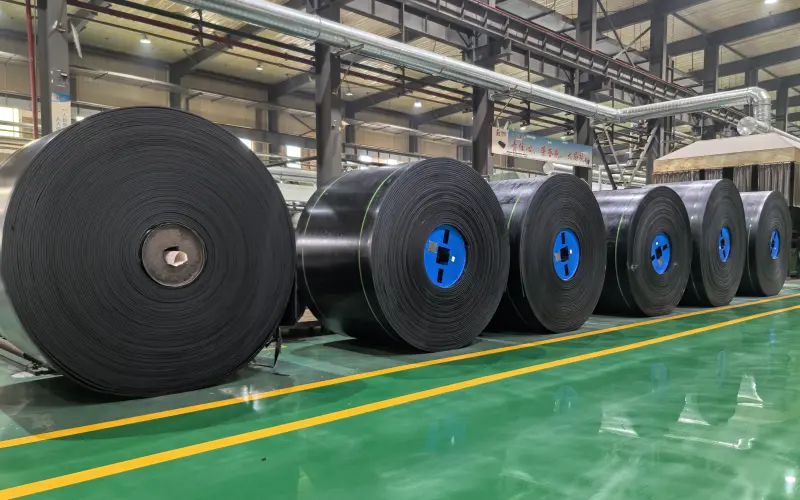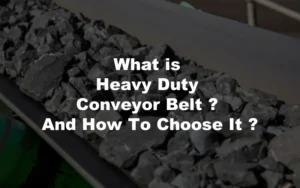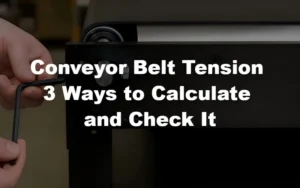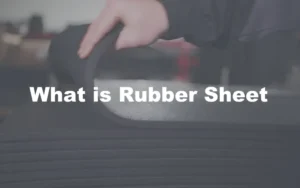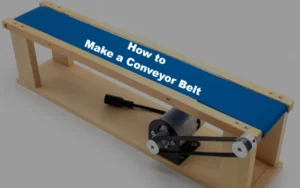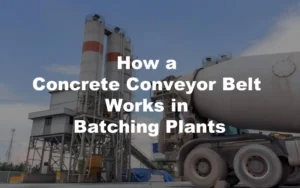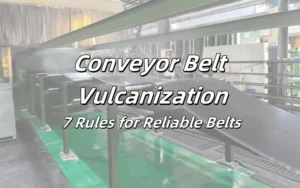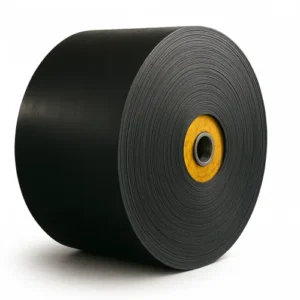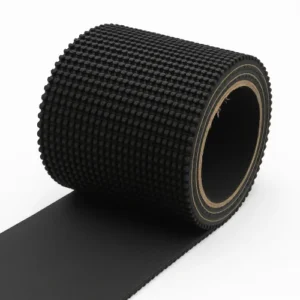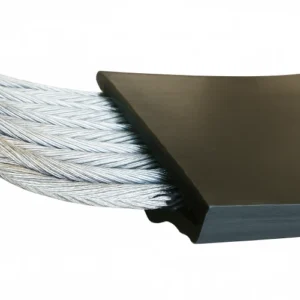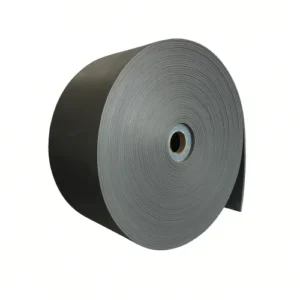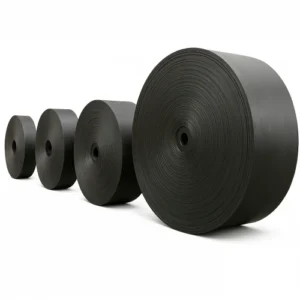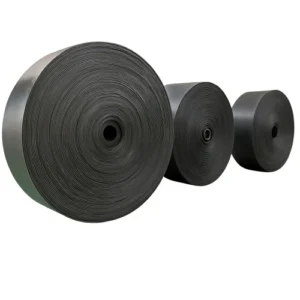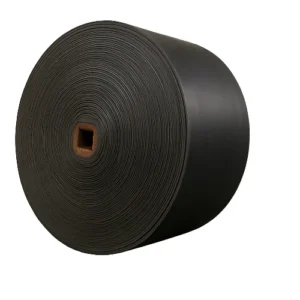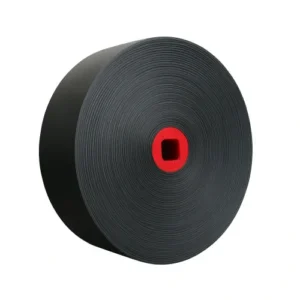1.Why Conveyor Belt Storage Matters More Than You Think
A year ago, I shipped a batch of rubber conveyor belts to a client in Southeast Asia, along with clear advice on proper conveyor belt storage. The belts were fresh from our production lines — the rubber smooth and flexible, the edges perfectly sealed, and every meter built to meet strict quality standards. They passed all inspections before leaving the factory, and I was confident they could deliver years of reliable service if stored and handled the right way.
When the shipment arrived, the client was busy with other projects. The belts were not installed immediately. Instead, they stayed in a warehouse for six months. This warehouse was in a coastal city, where the air was warm and heavy with humidity, often reaching over 80%. At first, it didn’t seem like a problem. The belts were still wrapped, still rolled, and no one thought much about them. But as I’ve seen many times, what looks fine at first can hide slow and steady damage.
Six months later, the belts were finally installed. For the first few months, they seemed to work well. But then the client called me, clearly concerned. Small cracks had appeared along the edges. The surface showed slight waves instead of lying flat. The belt felt stiffer than it should have been. He couldn’t understand why a new belt would start showing these signs so soon.
When I asked about the storage conditions, the cause became clear — the damage had started long before the belts touched the conveyor. They had been stored directly on a concrete floor, without a conveyor belt storage rack or stand to keep them off the ground. Afternoon sunlight from a nearby window had warmed the rolls daily, while high humidity seeped into the cut edges. The combination of moisture and heat acted slowly but relentlessly. Over months, the rubber aged faster, and the once-perfect rolls became slightly oval. By the time installation began, part of the average life of conveyor belt had already been lost.
This kind of slow, hidden damage is common in humid regions like Southeast Asia. You may not notice anything at first, but months later, it shows up as faster wear, loss of flexibility, and tracking problems. I have seen it happen to steel cord belts, EP fabric belts, chevron belts, and sidewall belts. Even the strongest designs can fail early if conveyor belt handling is neglected during storage.

The good news? It’s easy to prevent. Proper conveyor belt storage solutions are simple and cost-effective. A conveyor belt storage stand that lifts rolls at least 300 mm above the floor prevents moisture damage. A shaded, well-ventilated space slows aging. In very humid locations, using dehumidifiers or moisture-absorbing materials helps protect the belts. Adding a cover to block sunlight is another low-cost step that can make a big difference.
Think of conveyor belt storage like taking care of good tools or machinery. If you leave them exposed to weather, you shorten their life. Keep them protected, and they’ll serve you reliably. It’s not just about avoiding damage; it’s about making sure the belt performs at its best from the first day of use.
The average life of conveyor belt depends as much on storage as on manufacturing quality. Neglecting storage is like leaving a high-quality machine outside in salt air and rain — it might work for a while, but not for as long as it should. A belt is an investment, and every extra year you get from it is money saved.
In the next sections, I’ll explain how to protect different belt types, control environmental factors, support and rotate rolls, and choose effective protective covers. Whether your belts are in a dry inland plant or a humid tropical port, proper conveyor belt storage is one of the easiest and most profitable ways to protect your investment and avoid costly downtime.

2. Conveyor Belt Storage for Different Belt Types
When dealing with conveyor belt storage, a “one method fits all” approach simply doesn’t work. The internal structure, reinforcement material, and surface profile of each belt type respond differently to temperature, humidity, load distribution, and light exposure. Understanding these differences is the only way to make sure the belt you install performs as promised — and lasts as long as it should.
2.1 Conveyor Belt Storage for Fabric Core Belts (EP/NN/PN)
Risks if stored incorrectly:
- Loss of tensile strength due to water absorption at cut edges
- Distortion of belt geometry from uneven ply swelling
- Reduction in splice bonding quality if edges are exposed to fluctuating moisture levels
Why this happens:
Fabric plies in EP (polyester/nylon), NN (nylon/nylon), and PN (polyester/nylon) belts are made from organic polymer fibers. These fibers have microscopic capillaries that allow water molecules to enter. Even though the belt has rubber covers, cut edges and splice areas can wick in moisture. Over time, absorbed water causes the fibers to expand slightly, upsetting the tension balance between warp and weft threads. In high humidity environments (above 65%), this process is faster.
Correct storage measures:
- Store rolls at least 300 mm off the floor. Concrete and soil surfaces can accumulate condensation during temperature changes (“floor sweating”), which will transfer moisture to the belt’s edge. Elevating the roll also allows air to circulate underneath, reducing damp spots.
- Keep humidity at or below 65%. In climates without air-conditioned storage, position rolls in the driest part of the warehouse, away from exterior walls, roof joints, and open doors.
- Apply a compatible edge-sealing compound or cover the edges with polyethylene tape if belts will be stored longer than 90 days.
- Use a conveyor belt storage rackor cradle with a wide contact area to distribute weight evenly along the core. This avoids flat spots that can cause tension variation when the belt is unrolled.
Alternatives when ideal conditions are not possible:
- Without a dehumidifier, place large trays of calcium chloride, quicklime, or silica gel near the belt core to passively absorb moisture.
- Use breathable tarpaulin instead of plastic shrink wrap; sealed plastic can trap humidity inside and make things worse.
Common mistakes and consequences:
- Storing belts directly on concrete: leads to slow edge moisture uptake and dust contamination.
- Wrapping belts tightly in plastic in a humid warehouse: traps moisture against the rubber, creating a sticky film and accelerating cover degradation.
Recommended standards:
ISO 5285 and DIN 7716 provide guidelines on rubber product storage, including temperature and humidity limits for textile-reinforced belts.

2.2 Conveyor Belt Storage for Steel Cord Belts (ST)
Risks if stored incorrectly:
- Microfractures in cords from bending over too-small cores
- Uneven load on cords leading to tracking problems during operation
- Core collapse under the weight of the belt
Why this happens:
Steel cords are high-carbon steel wires with a protective zinc coating. They resist tension extremely well but are brittle when bent beyond a certain radius. If the core diameter is smaller than the manufacturer’s minimum (often 1.5–2.0 m depending on belt thickness), the steel strands inside are forced into a tight curve, creating permanent microfractures. Storing without rotation concentrates belt weight on one side, stretching those cords over time and creating asymmetrical tension.
Correct storage measures:
- Always use a core that meets or exceeds the belt’s minimum bending radius requirements.
- Store rolls upright, supported at both core ends on a conveyor belt storage stand that can carry the full belt weight.
- Rotate the roll 90° every 90 days in the direction indicated on the label to redistribute load evenly across the cords.
- Keep storage areas dry and free of corrosive fumes; even sealed cords can suffer galvanic corrosion if exposed to acidic or salty air for extended periods.
Alternatives when ideal conditions are not possible:
- If a larger core is unavailable, wrap the small core with layers of dense foam or plywood to increase its diameter before winding the belt.
- If you cannot rotate mechanically, roll can be shifted manually with adequate lifting equipment; avoid using pry bars or dragging.
Common mistakes and consequences:
- Laying the roll flat on the ground: the entire bottom section of the belt flattens and cords shift laterally.
- Lifting with a single-point hook: creates a bend radius smaller than the minimum, risking internal damage invisible from outside.
Recommended standards:
DIN 22131 and ISO 15236 cover steel cord belt design and handling parameters, including storage recommendations.

2.3 Conveyor Belt Storage for Chevron or Patterned Belts
Risks if stored incorrectly:
- Permanent flattening of raised profiles
- UV degradation of thin rubber at high points
- Uneven pattern deformation from localized compression
Why this happens:
Chevron and patterned belts have raised designs that are thinner than the main belt carcass. These sections heat up faster under sunlight and are more flexible, making them prone to compression damage. Stacking rolls directly causes the full load of the upper roll to rest on a small surface area of the lower roll’s pattern, permanently deforming it.
Correct storage measures:
- Store each roll separately on its own support. If vertical storage space is limited, insert lightweight separators (foam rings or corrugated cardboard spacers) so patterns do not carry the load.
- Cover belts with an opaque, breathable fabric to block UV rays while preventing trapped moisture.
- Keep storage temperature between 10–25°C to slow oxidation of the rubber compound.
- Maintain stable support across the entire core width to prevent the roll from leaning, which can distort the pattern alignment.
Alternatives when ideal conditions are not possible:
- In open storage, double-layer coverings (inner breathable cloth + outer waterproof tarp) can reduce UV damage and keep moisture out.
- In high-humidity climates, periodically uncover rolls on dry days to allow moisture escape.
Common mistakes and consequences:
- Wrapping rolls in clear plastic: traps heat inside, accelerating oxidation and surface hardening.
- Leaning rolls against walls: causes asymmetric compression, distorting pattern geometry.
Recommended standards:
While no standard focuses solely on patterned belts, following general ISO rubber storage guidelines is advised, with added emphasis on avoiding compression on raised features.

2.4 Conveyor Belt Storage for Sidewall and Cleated Sidewall Belts
Risks if stored incorrectly:
- Sidewall collapse or bending, affecting sealing efficiency
- Cleat misalignment, reducing carrying capacity
- Surface tearing from point pressure
Why this happens:
Sidewalls and cleats are bonded to the base belt with a secondary vulcanization process. Although the bond is strong, these vertical structures have a smaller cross-section and can bend under their own weight or from outside pressure. Rubber’s “memory” is limited; prolonged deformation will not reverse completely.
Correct storage measures:
- Fit rigid or semi-rigid support rings inside the roll to preserve its round shape.
- Avoid horizontal compression entirely; keep rolls spaced apart.
- Use wide, soft slings for lifting to prevent cutting or denting cleats.
- Store in temperature-controlled areas to maintain elasticity of sidewall rubber.
Alternatives when ideal conditions are not possible:
- If support rings are unavailable, use plywood discs or reinforced cardboard at both ends of the roll.
- For temporary outdoor storage, place rolls on raised pallets with full-width supports and cover with double-layer protection.
Common mistakes and consequences:
- Storing rolls under heavy pallets: flattens sidewalls, creating gaps during operation.
- Using steel cables for lifting without padding: leaves deep impressions that weaken the cleat-root connection.
Recommended standards:
No dedicated ISO/DIN for sidewall belts’ storage, but manufacturer-specific guidelines should be strictly followed due to the complexity of bonded components.

2.5 Conveyor Belt Storage for Pipe Conveyor Belts
Risks if stored incorrectly:
- Loss of edge overlap “memory” required for pipe closure
- Twisting or warping of edges from uneven contact pressure
- Failure to seal fine powders or prevent spillage
Why this happens:
Pipe belts operate by folding into a tube, with edges overlapping precisely. The edges must remain flexible and symmetrical. Long-term pressure on one edge flattens or shifts its profile, preventing proper sealing during operation.
Correct storage measures:
- Use a larger-than-standard core diameter to keep bending stresses low at the edges.
- Keep rolls upright on a conveyor belt storage stand with full-width core support.
- Prevent edges from contacting hard or sharp surfaces; use padding if necessary.
- Before installation, allow belts to rest for 24 hours at operating temperature to recover from any compression during transport.
Alternatives when ideal conditions are not possible:
- Wrap additional padding around core ends to further reduce bending at the edges.
- In outdoor temporary storage, place rolls on elevated racks and cover with breathable waterproof materials.
Common mistakes and consequences:
- Resting one edge directly on a floor or wall: deforms the sealing area, leading to continuous leakage during operation.
- Using undersized cores: accelerates permanent deformation of edge zones.
Recommended standards:
Refer to manufacturer-specific bending radius and edge-handling guidelines; pipe belt tolerances are typically stricter than flat belts.

2.6 Conveyor Belt Storage for Rip-Resistant / Anti-Tear Reinforced Belts
Risks if stored incorrectly
Rip-resistant belts are designed to take heavy punishment on-site, but their reinforced structure can be compromised before they even see service. Improper storage can cause stress marks in the reinforced layers, warping of embedded mesh, and small surface fractures that later develop into full tears under load.
Why this happens
These belts include extra materials like breaker plies or steel mesh beneath the rubber cover. While these layers give strength against ripping forces, they also reduce flexibility. When the belt is bent too tightly or stored on an undersized core, the reinforcement can distort or separate from the surrounding rubber.
How to store correctly
- Use a core diameter larger than standard flat belts — oversized cores reduce bending stress on the reinforcement.
- Keep the roll vertical with the core ends firmly supported to prevent sagging.
- Avoid folding or stacking rolls; these actions put uneven stress on the internal mesh.
- Maintain moderate temperature and humidity to prevent hardening or adhesive breakdown.
If you lack ideal conditions
- Add a temporary spacer layer, such as corrugated cardboard or foam wrap, around a smaller core before winding the belt.
- Place the roll on wooden beams or pallets to keep it off damp floors and improve air circulation.
Mistakes to avoid
- Rolling the belt on a small metal bar just to “save space” — this may lead to invisible internal cracking.
- Laying the roll flat for months — the reinforcement shifts and the belt may never run straight again.

2.7 Conveyor Belt Storage for Heat-Resistant Belts (DIN T1/T2/T3 or Equivalent)
Risks if stored incorrectly
Even though heat-resistant belts can handle high temperatures during operation, exposure to heat in storage will still damage them. Long-term heat or direct sunlight can dry out the cover rubber, create brittle zones, and shorten the usable life of the belt.
Why this happens
The compounds used in heat-resistant belts are chemically stable at elevated process temperatures but are still sensitive to continuous environmental heat. Heat speeds up oxidation, and UV rays from sunlight break down the polymer bonds, leading to surface chalking and cracks.
How to store correctly
- Keep belts in shaded, cool areas with good ventilation.
- Avoid any storage location close to hot machinery, steam pipes, or uninsulated roofs.
- Use light-reflective wrapping for outdoor short-term storage.
If you lack ideal conditions
- Use insulating panels between the belts and heat sources.
- Store belts low to the ground in cooler parts of the building.
Mistakes to avoid
- Leaving belts inside closed metal containers under the sun — interior heat can reach damaging levels in hours.
- Storing belts under skylights without covers — direct sun will accelerate degradation.

2.8 Conveyor Belt Storage for Oil-Resistant / Chemical-Resistant Belts
Risks if stored incorrectly
Contact with incompatible oils, fuels, or chemical vapors can weaken the belt cover. Even chemical-resistant grades can be damaged if exposed to substances they weren’t designed for. Over time, these interactions can make the belt soft, swollen, or brittle.
Why this happens
The protective properties come from specific additives in the rubber compound. When the belt is exposed to reactive chemicals or oil vapors, those additives can be consumed or displaced, leaving the rubber vulnerable.
How to store correctly
- Isolate these belts from any storage of oils, fuels, solvents, or corrosive agents.
- Keep them in well-ventilated, dedicated shelving or racks.
- Use liners or protective sheeting under and around the belts to prevent spills from reaching them.
If you lack ideal conditions
- Store the belt inside a sealed, chemical-resistant bag or crate.
- Place activated carbon pads or absorbent granules inside the enclosure to trap vapors.
Mistakes to avoid
- Placing belts next to drums of lubricants — vapors alone can start the degradation process.
- Wrapping belts in incompatible plastics — plasticizers can migrate into the rubber and cause surface tackiness.

2.9 Conveyor Belt Storage for Fire-Resistant / Anti-Static (FR/AS) Belts
Risks if stored incorrectly
Exposure to UV, ozone, or high-voltage discharge can degrade the compounds that make these belts fire-resistant and conductive. If these properties are lost, the belt may fail fire safety tests or cause unsafe static buildup.
Why this happens
FR/AS belts rely on chemical additives that suppress flames and conductive fillers that safely discharge static electricity. Ozone cracks the surface, UV breaks down the polymers, and contamination can insulate the surface against static flow.
How to store correctly
- Store indoors, away from sunlight, welding arcs, or high-voltage discharge points.
- Cover with opaque, breathable fabric that blocks UV without trapping moisture.
- Keep inspection areas grounded when belts are unwrapped to prevent static buildup.
If you lack ideal conditions
- Use temporary shielding or enclosures if belts must be stored near electrical equipment.
- Place ozone filters or deflectors between belts and any ozone-generating machinery.
Mistakes to avoid
- Leaving belts exposed in open yards — both UV and ozone in the air will accelerate surface aging.
- Placing belts near ozone-producing lights or high-frequency welders.

2.10 Conveyor Belt Storage for Cold-Resistant Belts
Risks if stored incorrectly
Cold-resistant belts are designed for low-temperature environments, but if stored in freezing conditions without protection, they can stiffen to the point of cracking during handling. Frozen condensation can also damage the cover and carcass.
Why this happens
Cold reduces the flexibility of the rubber, and below a certain point, the material behaves more like glass than an elastic compound. Any bending while in this state risks creating fractures.
How to store correctly
- Keep belts in temperature-controlled areas when possible.
- Before unrolling or installing, allow the belt to reach a temperature above 10 °C for at least a full day.
- Reduce humidity in storage to prevent condensation from freezing on the belt.
If you lack ideal conditions
- Store rolls in insulated covers or temporary heated shelters.
- Wrap the belt with thermal blankets to slow temperature changes.
Mistakes to avoid
- Handling belts immediately after removal from cold storage.
- Storing outdoors in freezing rain without any cover — ice can penetrate edges and weaken internal plies.

3. Conveyor Belt Storage Conditions
When I first started working with conveyor systems fifteen years ago, I made every storage mistake possible. Belts stored in direct sunlight developed surface cracks within months. Others left on concrete floors absorbed moisture that later caused tracking problems. The expensive lesson taught me that conveyor belt storage isn’t just about finding empty space—it’s about protecting a significant investment.
3.1 Temperature Management That Actually Works
Conveyor belt storage conditions don’t require perfect climate control, but they do need consistency. These belts operate in extreme temperatures daily, yet storage temperatures between 10-25°C prevent unnecessary rubber degradation.
Direct sunlight poses the biggest threat in hot climates. I’ve seen rubber surfaces turn chalky after six months of window exposure. Simple solutions work best: shade cloth, proper ventilation, or moving storage away from heat sources. In cold environments, the belt handles low temperatures fine, but handling frozen belts causes surface cracking. Always allow cold belts to warm gradually before unrolling.
Temperature swings create condensation problems. Moving a cold belt into warm, humid air generates moisture that penetrates cut edges and splice areas. Use gradual warming or moisture barriers to prevent this common issue.

3.2 Humidity Control: The Silent Destroyer
Moisture attacks the non-rubber components first—fabric layers, steel cords, and adhesive bonds. Keeping storage humidity below 65% prevents edge swelling and steel corrosion that reduces belt life significantly.
Good air circulation solves most humidity problems. Fans, vents, or basic dehumidifiers maintain dry conditions without major expense. For smaller operations, silica gel packs inside roll cores control local moisture effectively. Never wrap damp belts in plastic—trapped moisture accelerates deterioration.

3.3 Contamination Prevention
Years of troubleshooting belt failures taught me that contamination damage accumulates slowly. Dust, oils, and chemical vapors penetrate rubber surfaces over months, causing softening, staining, and splice failures.
Keep conveyor belt storage areas separate from maintenance zones, welding areas, and chemical storage. Elevate belts on clean racks—never store directly on floors where debris accumulates. Regular inspection catches contamination before it causes permanent damage.

3.4 Proper Load Distribution
Heavy conveyor belt rolls create their own problems. Uneven support causes flat spots and permanent set marks that affect tracking performance. Support rolls through their core using dedicated conveyor belt storage racks or stands.
Stacking rolls requires careful planning. Use wide, flat spacers to distribute weight evenly and keep stacks low. Better yet, invest in proper storage stands that eliminate stacking entirely. The cost is minimal compared to replacing deformed belts.

3.5 Chemical and Environmental Protection
Chemical vapors damage belts without direct contact. Fuel fumes, cleaning solvents, and industrial chemicals cause rubber swelling and steel corrosion over time. Separate belt storage from chemical areas whenever possible.
When space is limited, use chemical-resistant covers with vapor-absorbing packs. This approach costs less than replacing damaged inventory and prevents contamination issues during installation.

3.6 Handling and Impact Prevention
Fork truck damage accounts for more storage-related belt failures than environmental factors. One impact can dent cores, crack covers, or damage splice areas beyond repair.
Design storage layouts with adequate clearance for safe equipment movement. Use proper lifting equipment—spreader bars and lifting beams prevent edge damage during handling. Train all personnel on correct belt moving procedures.

3.7 UV and Light Protection
UV exposure makes rubber surfaces chalky and reduces flexibility gradually. Indoor storage near windows creates the same problems as outdoor exposure over time.
UV-blocking films on windows or opaque covers on rolls provide effective protection. For outdoor storage, use breathable inner covers for airflow with UV-resistant outer covers for weather protection.

3.8 Fire Safety Considerations
Even flame-resistant belts require proper storage precautions. Sparks, open flames, or sustained high heat can alter belt properties and create safety hazards in storage areas.
Position all belts away from welding operations, heating equipment, and potential ignition sources. Use storage racks that don’t obstruct sprinkler systems or fire suppression equipment. Keep storage areas clear of flammable materials and debris that could fuel fires.
3.9 Safety and Inspection Protocols
Full conveyor belt rolls weigh thousands of pounds. Improper storage creates serious safety hazards and equipment damage risks. Use storage stands rated for belt weights with proper securing mechanisms.
Schedule inspections every 90 days minimum. Check cover integrity, support equipment condition, and environmental factors. Rotate stored belts slightly to prevent pressure concentration. Document conditions and actions taken for future reference.
3.10 Real-World Applications
The mining operation in Chile stores belts in a purpose-built warehouse with temperature control and humidity monitoring. Their belts maintain factory condition for over two years. The port facility in Malaysia uses simple shade structures and ventilation fans—their storage costs dropped 60% while belt performance improved.
Both operations prove that effective conveyor belt storage solutions don’t require expensive infrastructure. They need planning, attention to detail, and recognition that proper storage pays for itself through extended belt life and reduced downtime.
Smart storage protects your investment from day one. Every dollar spent on proper storage conditions saves multiple dollars in replacement costs and operational disruptions.
4. Rolled on a Core for Proper Conveyor Belt Storage
Over the years, I’ve seen how a simple thing like the way a belt is rolled can make or break long-term conveyor belt storage. You might think the belt is strong enough to sit in any position, but the truth is, the choice of core, rolling direction, and handling method will decide whether that belt comes out of storage in perfect shape or with built-in problems. I treat the core as part of the product, not just packaging — and you should too.
4.1 Core Material and Structure
In conveyor belt storage, the core takes the full weight of the roll, so it needs to be solid. Steel cores are my top choice for long-term storage because they don’t warp, even in humid climates. Heavy hardwood cores work well too, especially if you want something easier to handle in smaller facilities.
A strong core keeps the belt round and prevents sagging, which means less stress on the carcass during storage. For heavy belts, I prefer a square-hole core because it works with spreader bars, making conveyor belt storage safer and avoiding edge damage during lifting. Round-hole cores are fine if you have the right spindle, but they limit your handling options.

4.2 Rolling Direction
I always roll belts with the carrying side facing out during conveyor belt storage. This isn’t about looks — it’s about protecting the belt’s working surface. Rolling it the wrong way can leave pressure marks on the cover or trap it against the core for months.
When the carrying side is out, it’s easier for me to check the surface during storage inspections. If you store multiple rolls, having the carrying side visible also helps you identify them quickly without unrolling. That small detail keeps conveyor belt storage organized and damage-free.
4.3 Core Diameter Standards
One of the easiest mistakes in conveyor belt storage is using a core that’s too small. A small diameter increases bending stress, which can weaken the bond between layers over time. Steel cord conveyor belt storage is especially sensitive to this — too tight, and you’re stressing the cords for no reason.
I follow the manufacturer’s minimum diameter as a rule, but I prefer going slightly larger for long-term conveyor belt storage. Fabric conveyor belt storage can tolerate tighter rolls, but even then, there’s no benefit in pushing the limit. A larger core is simple insurance against hidden damage.

4.4 Factory Labels and Direction Marking
Clear labels are part of smart conveyor belt storage. Every roll should have details like type, length, width, and rotation direction. If I receive a roll without visible labels, I make my own before it goes into storage.
For chevron conveyor belt storage, rotation direction is not optional — install it the wrong way, and you’ll have performance issues. By marking it clearly at the start, I make sure that months later, the belt still comes out of conveyor belt storage ready for correct installation.

4.5 Compatibility During Transport and Installation
The core you choose affects more than just conveyor belt storage. If it’s not compatible with your lifting equipment, you’ll waste time and risk damage during handling. I’ve seen rolls damaged simply because someone had to improvise a lift.
For long-distance transport, a strong core prevents deformation from tight strapping or movement inside containers. When installation day comes, a well-matched core lets the belt unroll smoothly onto the conveyor without binding or wobbling. Good conveyor belt storage solutions mean thinking ahead to that moment, not just the months in between.
In my experience, getting the core right is one of the easiest ways to guarantee successful conveyor belt storage. When you combine the right material, correct diameter, proper rolling direction, and clear labeling, you set yourself up for smooth handling, safe storage, and a belt that’s ready to perform the moment it leaves the conveyor belt storage rack or conveyor belt storage stand.
5. Properly Supported for Effective Conveyor Belt Storage
When people ask me about conveyor belt storage, one of the first things I tell them is this: “Never underestimate the power of gravity and bad luck.” If you store a belt without proper support, gravity will bend it, twist it, and turn it into a shape you never ordered — and bad luck will make that happen right before you need it. So let’s talk about keeping your belts properly supported from day one.
5.1 Why You Should Never Store a Belt Directly on the Floor
I know the floor looks like a big, flat, free storage space. But for conveyor belt storage, it’s the worst roommate you can give your belt. Floors collect moisture, dirt, and dust. In humid areas, that moisture creeps up into the belt edges. Even if your belt is made from durable rubber, over time this can affect the carcass or steel cords inside.
By keeping your belt at least 300 mm (about a foot) off the ground, you block that ground moisture and make it harder for dust and grit to stick. It also means forklifts and pallet jacks have an easier time getting underneath without bumping or scraping the roll. That’s why every conveyor belt storage rack or conveyor belt storage stand I build is designed to lift the belt roll clear off the floor.

5.2 The Danger of Horizontal Storage
Laying a belt roll flat on its side might seem stable, but in conveyor belt storage terms, it’s asking for trouble. The roll will press down on the lower edge, causing deformation and sometimes an oval shape we call “bowing.” This isn’t dangerous to look at, but once you try to install that belt, you’ll wish you had kept it round.
Bowed belts can also trap moisture between the layers, especially in EP conveyor belt storage or fabric conveyor belt storage. That trapped moisture can slowly work into the edges or weaken the splice area. Standing the belt roll upright, fully supported through its core, keeps the weight distributed evenly.

5.3 The Right Support Structure
If you want proper conveyor belt storage solutions, invest in stands or racks that match the belt’s size and weight. The support should be wide enough to spread the load, strong enough to handle the roll’s mass, and stable enough that it won’t tip over if someone bumps it.
I like using cradles for smaller rolls and full storage racks for larger ones. For very heavy belts, especially steel cord conveyor belt storage, I make sure the rack has reinforced arms and locking pins to keep the roll in place. A roll falling off a rack isn’t just an expensive mistake — it’s a hazard to anyone nearby.
5.4 Transport Stands vs. Storage Stands
Here’s something beginners often miss: the stand you use for transport isn’t always the stand you should use for long-term conveyor belt storage. Transport stands are built to survive bumps, straps, and vibration. Storage stands are designed to keep the belt steady and supported over months or years.
If you use a transport stand for storage, you might be putting too much pressure on small contact points. Over time, that can create indentations in the belt or even stress the core. If I’m planning to store a belt for more than a few weeks, I transfer it to a proper conveyor belt storage rack as soon as it arrives.

5.5 Choosing Support for Large vs. Small Rolls
Not all belts are the same size, and neither should their supports be. Smaller rolls can sit comfortably in a V-shaped cradle or between rollers, making them easy to rotate during inspections. Large rolls — especially those used in heat resistant conveyor belt storage or sidewall conveyor belt storage — need solid axle support that can handle the weight without bending.
Think of it like storing a giant wheel of cheese: small ones fit on a shelf, big ones need their own stand. If you mismatch the belt size and the support, you’re either wasting space or risking damage.

Proper support is the foundation of good conveyor belt storage. Without it, every other precaution — controlling humidity, avoiding UV, keeping it clean — becomes less effective. When your belts are stored high enough to avoid ground moisture, upright to prevent bowing, and secured in a rack that matches their size, you’re not just storing them — you’re protecting your investment.
And remember: belts don’t complain if they’re uncomfortable, but they will “get even” by giving you trouble later. Give them the right support now, and they’ll repay you with smooth starts, fewer stoppages, and a much longer working life.
6. Rotated on Its Stand for Better Conveyor Belt Storage
One thing I’ve learned in all my years with conveyor belt storage — belts are like people sitting in the same position for too long. If you never move them, they get stiff in one spot. You wouldn’t sit on the same chair without moving for three months, right? (If you do, we need to talk!) Belts feel the same way.
6.1 Why Rotation Matters
When a belt sits in one position for months, the weight of the roll presses down on the same section of rubber and carcass. Over time, this can create flat spots, uneven tension, or even stretch marks. This is especially true for steel cord conveyor belt storage, where the cords can take a “set” from long-term compression.
By rotating the roll on its stand, you spread that pressure around the entire circumference. In fabric conveyor belt storage, this helps keep the plies evenly supported. In sidewall conveyor belt storage or chevron conveyor belt storage, rotation prevents the patterned surfaces from becoming permanently indented on one side.
6.2 How Often Should You Rotate?
For most situations, I follow the 90-day rule: every three months, give the roll a quarter turn in the direction marked by the manufacturer. This keeps conveyor belt storage stress balanced without making rotation a full-time job. If your storage area has high humidity or temperature changes, rotating every 60 days can be even better.
And yes, I always follow the rotation arrows. They’re not decoration — they’re there to prevent the belt from loosening or twisting the wrong way. In EP conveyor belt storage, going against the arrow can actually shift the internal tension, which is the last thing you want before installation.
6.3 Marking the Rotation Direction
If the factory labels are missing or hard to see, I make my own rotation marks. A bright paint stripe works well, or even colored tape. Just make sure it’s something that won’t peel and stick to the belt surface. Clear marking makes rotation simple, even if someone else is doing it for you.
In large storage facilities with multiple conveyor belt storage racks, I also mark the last rotation date right on the stand. This avoids the classic “Did we already rotate this one?” conversation that happens when nobody remembers.
6.4 Safety When Rotating
Rotating a belt roll sounds easy, but remember — some rolls weigh several tons. You don’t “just push it a little.” Always use proper lifting equipment or stands designed for easy turning. If you’re rotating a roll on a conveyor belt storage stand, check that the bearings or rollers are clean and free of debris before starting.
For very heavy belts, like those in heat resistant conveyor belt storage or cold resistant conveyor belt storage, I prefer using a spreader bar with slings so we can lift and turn without putting side pressure on the core.
6.5 What Happens If You Don’t Rotate?
If you skip rotation, you might still get away with it — for a while. But eventually, you’ll notice the belt unrolling unevenly, or the splice area being stiffer than the rest. In the worst case, you’ll end up with a permanent bend that no amount of stretching will fix. That’s when you realize conveyor belt storage solutions aren’t just about keeping it dry and clean — they’re also about keeping it moving, even in storage.

7. Properly Protected in Conveyor Belt Storage
When I talk about conveyor belt storage, I always say: “A stored belt is like a sleeping worker — it still needs the right environment to stay in good shape.” Leaving a belt unprotected is like letting it nap outside in the sun, in the rain, and next to a barbecue. Sure, it might survive, but it won’t be ready to work at its best when you need it. Protection is not just a nice extra; it’s part of the belt’s long-term health plan.
7.1 Indoor First, Outdoor Only If You Must
Whenever possible, keep conveyor belt storage indoors. Even a simple warehouse offers protection from UV rays, rain, and extreme weather changes. Sunlight can fade the cover and cause surface cracking over time, while water can creep into cut edges or splices, especially in fabric conveyor belt storage.
If you absolutely must store outside, don’t just throw a tarp over it. Make sure the belt is on a conveyor belt storage rack or conveyor belt storage stand to keep it off the ground, and use a proper weatherproof cover. For steel cord conveyor belt storage, seal the ends to keep water out of the cords — moisture inside steel cords is like rust waiting to happen.
7.2 Why I Like PP Covers for Belt Protection
I’ll be honest — my favorite choice for covering belts in conveyor belt storage is PP (polypropylene) material. Why? Because it’s tough, waterproof, UV-resistant, and it doesn’t rip when you’re moving the roll around. If someone brushes past with a forklift or a pallet, the PP wrap takes the hit, not your belt.
PP covers are also great for outdoor situations where you can’t control the weather. They block sunlight, keep out rain, and resist tearing even in windy conditions. In steel cord conveyor belt storage, a well-sealed PP wrap at both ends means no moisture sneaks in to corrode the cables.
But here’s the trick — even with PP covers, I avoid completely airtight wrapping. A little air circulation prevents condensation buildup, which is especially important in EP conveyor belt storage and fabric conveyor belt storage. You want it dry, not trapped in its own little greenhouse.
7.3 Avoiding High-Risk Storage Areas
Protection in conveyor belt storage isn’t only about covers. Location matters too. Keep belts away from high-voltage equipment that produces ozone, because ozone can make rubber crack faster than normal. Avoid storing belts near oil, solvents, or chemicals that could splash onto them. In heat resistant conveyor belt storage or oil-resistant belt storage, contamination can reduce the special properties you paid for.
7.4 Guarding Against Physical Damage
Sometimes, the enemy of conveyor belt storage is not the weather — it’s people and machinery. Forklift tines, falling tools, or even boxes stacked too close can cause dents, cuts, or edge damage. That’s why I always store belts with enough clearance around them and use conveyor belt storage racks or stands that keep them secure and out of harm’s way.
7.5 Balance Between Protection and Breathability
Overprotecting a belt can backfire. If you wrap it in layers of plastic and tape, you might keep water out, but you also trap humidity in. That trapped moisture can condense when the temperature changes, which is bad for cold resistant conveyor belt storage or belts stored in humid climates. The best conveyor belt storage solutions use covers that block the bad stuff but still let the belt “breathe” enough to stay dry inside.
For me, proper protection in conveyor belt storage is like giving the belt a comfortable, clean room where it can wait until it’s needed. Whether that’s using a strong PP cover, choosing the right indoor spot, or keeping it away from risky environments, it’s all about making sure the day you unroll it, it’s ready to perform exactly as it did on the day it was made.

8. Lifted Correctly in Conveyor Belt Storage
You might think lifting a belt roll is just about getting it from point A to point B. But in conveyor belt storage, how you lift the belt is the difference between a smooth installation and a very expensive repair bill. I’ve seen belts worth thousands damaged in less than five minutes — not because the belt was faulty, but because it was lifted the wrong way. And trust me, belts don’t forget. They’ll show those dents, scratches, or internal stress marks for the rest of their working life.
8.1 Choosing the Right Lifting Tools
In proper conveyor belt storage solutions, the tools you use for lifting matter. I always recommend using a spreader bar with lifting slings, or a square lifting beam combined with a separation bar. Why? Because these tools distribute the weight evenly across the core.
If you just hook a chain through one side of the core, you put all the stress on a small section — which can crush the core, deform the roll, or even crack the inner liner in EP conveyor belt storage or fabric conveyor belt storage. For heavy rolls in steel cord conveyor belt storage, improper lifting can actually kink the cables inside, permanently weakening the belt.
8.2 Matching Equipment to Belt Size and Weight
Not all belts weigh the same. A light belt for chevron conveyor belt storage might only need a light-duty beam and two people to maneuver it. A massive roll for heat resistant conveyor belt storage can weigh several tons and needs heavy-duty lifting equipment with the right safety certifications.
Using equipment that’s too light for the job is like using dental floss to tow a car — it’s not going to end well. Always check the weight rating of your lifting gear before touching the belt.
8.3 Protecting the Belt Edges During Lifting
Edges are one of the most vulnerable parts in conveyor belt storage. A forklift tine, a sharp chain link, or even rough sling material can cut into the belt surface. I use edge protectors made from rubber or soft plastic to make sure nothing sharp touches the belt.
For sidewall conveyor belt storage, I’m extra careful — the sidewalls and cleats are more delicate than the flat section of the belt. Any crushing or bending during lifting can leave permanent marks that affect performance on the conveyor.
8.4 Teamwork and Communication
Lifting a belt is rarely a one-person job, especially in large-scale conveyor belt storage racks or warehouses. You need at least two people — one to operate the lifting equipment and one to guide the roll. And you need clear signals or radios to coordinate movements.
I’ve seen more damage caused by poor communication than by bad equipment. One person thinks “up,” the other thinks “forward,” and the belt ends up scraping against a steel column. It’s not the kind of memory you want to create.
8.5 Lifting in Tight or Awkward Spaces
In some conveyor belt storage stands, space is tight, and you can’t just swing the roll freely. In those cases, I plan the lift in stages — moving it vertically first, then rotating it, and finally lowering it into position. Sometimes you need low-profile lifting beams or compact spreaders to make it work without bumping into walls or racks.
For cold resistant conveyor belt storage, I take extra care in cold conditions because the belt can be stiffer. Sudden bending while lifting can create micro-cracks in the cover.
8.6 Why Good Lifting Habits Pay Off
The truth is, in conveyor belt storage, every lift is a chance to damage the belt — or a chance to prove you know what you’re doing. Proper lifting habits protect the core, the edges, and the overall shape of the roll. That means when you finally install it, you’re working with a belt that’s still in perfect condition, not one that’s already been compromised before its first run.
And here’s my rule: if the belt is valuable enough to store carefully, it’s valuable enough to lift correctly. You wouldn’t pick up a brand-new TV by the screen — so don’t pick up a belt by the wrong spot either.
Correct lifting in conveyor belt storage isn’t complicated, but it does require attention to detail. Use the right tools, match them to the belt’s size and weight, protect the edges, and make sure everyone involved knows the plan. Do that, and you’ll avoid the kinds of costly mistakes that too many people only learn about after it’s too late.

9. Storage & Handling in Conveyor Belt Storage
When it comes to conveyor belt storage, the “storage” part is only half the story. The way you handle the belt before, during, and after storage can decide whether it runs perfectly for years or starts causing trouble after a few months. I’ve seen belts stored in perfect conditions, then ruined in the last ten minutes of handling — which is like babysitting a cake all day and dropping it just before serving.
9.1 Keep the Belt Roll Surfaces Clear
Never use the top of a stored belt roll as a workbench. In fabric conveyor belt storage or chevron conveyor belt storage, even light boxes can create flat spots or marks that affect tracking.
Why: The roll already carries its own weight on the bottom layers; extra weight on top increases pressure and distorts the belt shape.
How: Use dedicated racks, and clearly mark “no load on top.” If your space is tight, go for vertical conveyor belt storage racks so nothing is placed on the rolls.
9.2 Manual Handling Without Damage
In some situations, lifting equipment isn’t available. When that happens, move the belt using a rod or shaft through the core, with two or more people sharing the load. Never pull by the belt edge — in sidewall conveyor belt storage, pulling on the sidewall can permanently bend or crack it.
Why: Edges and sidewalls are more fragile than the flat surface. Pulling stretches or tears the rubber.
How: Insert a clean rod through the core, protect edges with soft pads, and roll the belt over a clean sheet if it must be moved on the ground.
9.3 Avoid Direct Harmful Contact
Contrary to some myths, being “near” chemicals doesn’t usually harm a belt. The real danger in conveyor belt storage comes from direct surface contact with reactive substances like solvents, oils, uncured paint, or greasy pallets.
Why: Prolonged contact can soften, swell, or stain the cover rubber.
How: Keep belts on clean surfaces. Add a PP sheet or HDPE board under the belt. For cut edges, wrap them with protective tape to stop wicking.
9.4 Moving Belts Without Internal Stress
When moving belts between racks or machines, avoid sudden drops or sharp angles. This is critical in steel cord conveyor belt storage, where bending the core can kink the internal cables.
Why: Stress inside the carcass is invisible but can lead to failure under tension during operation.
How: Keep the belt axis horizontal during lifts, use rollers or guides, and plan the path so the belt moves smoothly from start to finish.
9.5 Smooth Transfers Between Different Systems
If you transfer a belt from one conveyor or storage stand to another, keep the transition smooth. Use rails, skids, or low-friction rollers.
Why: Sudden stops or bumps can shift the belt layers inside the roll, making it harder to unwind later.
How: Prepare the route before moving. Remove obstacles and keep the path wide enough for the roll’s diameter plus clearance for lifting gear.
9.6 Prevent Damage From Problem Surfaces
In conveyor belt storage solutions, it’s not just chemicals that are risky — dirty or rough contact surfaces can also cause trouble.
Why: Dust, rust flakes, or rough timber edges can scratch the cover. Oils from treated wood or machinery can seep into the belt over time.
How:
- Check the contact surface before placing the roll.
- If you see dust, oil, or sharp points, clean or cover them.
- Use PP or PE covers on all rack contact points.
- In humid areas, add a moisture barrier like kraft paper under the belt to avoid condensation marks.
9.7 Short-Term vs. Long-Term Handling Plans
Different timelines require different approaches in conveyor belt storage.
Short-term (≤30 days):
- Keep the factory wrap on until installation.
- Store on clean racks for quick access.
- Tag rolls for size and installation date to avoid unnecessary moves.
Long-term (≥90 days):
- Place the belt once and avoid moving it.
- Elevate at least 300 mm above the floor to prevent ground moisture transfer.
- Rotate the roll every 90 days to spread internal stress.
- Wrap with UV-protective PP outer covers but allow small vents to avoid condensation.
- Keep a handling log so anyone moving the belt follows the same process.
Why: Short-term storage is about speed and accessibility; long-term storage is about stability and protection.

10. Proper Storage Techniques for Conveyor Belt Storage
I’ve spent more years than I can count working in a factory that makes these belts — cutting, curing, testing, and shipping them. I know exactly how tough they are on the job, and I also know how quickly they can age if stored the wrong way. That’s why I’m going to walk you through what I’ve seen work best for conveyor belt storage, so your belt will still look and perform like new when it finally hits the conveyor.
Let’s start with something simple: don’t send a belt into storage dirty or wet. Before we ship a belt out, it’s clean and dry. If you store it covered in material residue or with moisture trapped inside, you’re basically starting the clock on early aging. In fabric conveyor belt storage, water can sneak into the cut edges and weaken the carcass over time. For steel cord conveyor belt storage, moisture leads to rust inside — and once that happens, there’s no turning back.
Next, wrapping. I’ve seen customers skip this step thinking, “It’s just in the warehouse; it’ll be fine.” Then sunlight creeps in through a side door, or dust from a nearby workshop settles on the surface. I like PP outer covers because they’re strong, waterproof, and UV-resistant. They’re basically armor for your belt during downtime. But leave small breathing gaps so you don’t trap condensation inside.
Height matters too. In the factory, we never leave rolls directly on the floor — not even for an hour. We keep them at least 300 mm off the ground using a conveyor belt storage stand or rack. This keeps them away from ground moisture, stray oils, or whatever your forklift drags in from outside.
Now about position — belts are designed to stand upright on their core. If you lay them flat for long storage, the roll can go oval. Once a roll loses its round shape, getting it to run straight later can be like trying to roll a potato in a straight line. For chevron conveyor belt storage, improper positioning can even flatten the patterns.
Space is always a fight in warehouses, but stacking rolls is a gamble you’ll lose eventually. Heavy rolls press down on the ones below, and I’ve seen patterned belts with permanent dents because someone thought “just for a week” wouldn’t matter. If you have no choice but to stack, use strong racks that support each roll fully, and don’t go more than two layers.
Climate is another factor. No, belts aren’t fragile — many can handle up to 70°C on the job — but long-term exposure to extreme heat or cold will still speed up aging. Store them somewhere with stable conditions. In humid regions, like parts of Southeast Asia, I recommend using fans or dehumidifiers to keep the air moving and the relative humidity reasonable.
For distributors with many belts in conveyor belt storage solutions, organize by type and installation date, and rotate stock using FIFO. This isn’t just about neatness — rubber ages over time, even in perfect storage. For end users, keep your spare belt close to where it’ll be installed. When your conveyor is down, you don’t want to dig through a warehouse maze to find the belt.
In the factory, we treat every belt like it’s going to a competition — clean, wrapped, supported, and ready to work. If you handle your belts with the same care we do before they leave our door, you’ll get the full average life of a conveyor belt — and maybe more. Ignore these steps, and that “new” belt might already be halfway through its life before it even turns a pulley.

11. Long-Term Storage for conveyor Belt storage
When I say “long-term,” I’m talking about anything close to a year. Many factories set warranty at twelve months—it’s not everyone, but it’s common—so I plan conveyor Belt storage with that in mind. If your contract says more or less, follow that; what I’m giving you here is a safe, real-world baseline so the belt you pull from the rack still looks like it left our vulcanizer yesterday.
Think of the year in two halves. In the first six months, the belt is still “fresh.” Keep it clean, dry, and off the floor and you’re fine. Between six and twelve months, little issues grow teeth: light surface hardening, edge scuffs turning into problems, moisture sneaking in where it shouldn’t. That’s where a few disciplined habits pay off.
Start with contact surfaces. The belt doesn’t mind sitting quietly; it minds what it sits on. Oily pallets, freshly painted steel, and old timber that bleeds resin will all share their “personality” with your cover. I line rack arms and pallets with clean PP or HDPE sheets and only then set the roll down. Lay a clean PP/HDPE liner on the rack first and it shields EP, fabric, and steel-cord belts just the same—no oil bleed, no paint rub, no surprises.
Wrap like you mean it. I prefer a PP outer cover—tough, waterproof, and UV-resistant. It doesn’t tear when the forklift gets too friendly, and it keeps stray sunlight from chalking the rubber. Don’t shrink-wrap the roll into a mini-submarine; leave small breathing gaps so condensation doesn’t party inside the package. In hot, humid warehouses, that alone can save you from a lot of “why is this sticky?” phone calls. Call it low-cost, high-return conveyor belt storage solutions.
Support and position are non-negotiable. Rolls live upright on the core, not on their sides. Raise every roll a minimum of 300 mm on a conveyor belt storage rack or conveyor belt storage stand so it stays clear of floor damp, grit, and those “where did that come from?” puddles. Mark a clear rotation arrow on the core and give the roll a quarter-turn every ninety days. Gravity is patient; rotation keeps it from leaving a signature. With chevron conveyor belt storage or sidewall conveyor belt storage, this also prevents patterns and cleats from taking a permanent nap.
Environment doesn’t have to be fancy. These belts work hard in the field; they don’t need a lab. But year-long heat and UV will age a cover faster, and deep cold makes handling stiffer than it needs to be. I use shade, airflow, and common sense: block sunlight, run fans in humid seasons, and don’t park belts next to ozone-heavy equipment. For heat resistant conveyor belt storage or cold resistant conveyor belt storage, a light-colored outer wrap helps reflect heat in summer and reduces “sweating” in winter.
Past the six-month mark, I add one ritual: edge and seal checks. If a cut edge shows nicks, lifted sealing, or (for steel cords) a hint of rust stain, fix it now. A small repair today beats a splice headache tomorrow. Run a hand around the outer wraps—if the surface feels unusually stiff or you see flat spots from a point load, correct the support and rotate.
Handling is where good belts get hurt quickest. Lift with a square spreader and soft web slings, and clip on edge protectors—keep steel hardware away from the rubber, full stop. For long, heavy rolls, separate slings so the load doesn’t crush sidewalls or cleats.
When the belt is finally called to duty—no “trial runs,” this isn’t a motor—you prep like a pro. Move the roll to the installation area and let it acclimate for about 24 hours so it’s not carrying warehouse temperature into the splice. Loosen one or two outer wraps, check feel and flexibility, and take a look at the edges for compression marks. For the first run, begin at the low end of the tension spec, let the belt relax under a light load, then fine-tune up to the final setting. That gentle ramp protects the carcass after months of rest.
Tag every roll for FIFO and sketch a straight route from rack to install so you only handle it once. A clear tag (type, width, length, cover grade, arrival month) and a simple route—rack → lift point → staging → installation—mean you only touch the roll once. Every extra shuffle is an extra chance to scuff something you paid good money for.
Do these small things consistently and a year of conveyor Belt storage won’t steal from the average life of conveyor belt you expect. Skip them, and you’re not storing a belt—you’re aging it. I build them to work; treat them like equipment, not furniture, and they’ll return the favor on the line.

12. Storage Ideas & Containers for better conveyor Belt storage
I’m the factory tech who sees belts before the crate closes and after they come back with complaints. The aim is simple: set up conveyor Belt storage so a roll leaves the rack like a pro—no limping, no mystery damage.
12.1 Vertical racks that respect the roll.
Tight on floor space? Stand rolls upright—proper conveyor belt storage rack spreads load at the core (lined arms with PP/HDPE), keeps ≥300 mm off the floor, and anchors to stop tip-overs. Strap the roll so a forklift nudge isn’t bowling night. Patterned belts need kindness: for chevron conveyor belt storage and sidewall conveyor belt storage, add soft contacts or profile spacers so nothing flattens while waiting.
12.2 Reusing the supplier’s steel A-frame.
Steel-cord belts often arrive “eye-to-side” on heavy frames. You can keep that frame for steel cord conveyor belt storage—verify SWL, bolt the feet, line every metal touch point, and confirm the core bar matches the spec. If it’s “eye-to-sky,” that’s staging, not housing; convert to core support for anything beyond a short pause.
12.3 A small temperature bay, not a climate lab.
You don’t need to condition the whole warehouse. Build a compact insulated corner: sandwich panels, shade, quiet airflow. Stage belts here 24 h pre-install so they acclimate. It pays off with heat resistant conveyor belt storage and cold resistant conveyor belt storage—gentler handling, cleaner splices, fewer complaints.
12.4 Moisture control without drama.
Humidity walks in every time the door opens. Keep it boring: cross-vent with two fans, use PP wrap that breathes (never a sealed jar), and slide a humidity card into the core so you read, not guess. In tropical sites, drop a small desiccant bag inside the wrap. These low-tech moves protect edges and splice zones across EP conveyor belt storage, fabric conveyor belt storage, and steel-cord belts.
12.5 Labels you can see from the aisle.
Belts “vanish” when labels do. Print big tags—width × length × carcass × cover grade—and add a QR/barcode to a one-pager (arrival month, rack slot, job). Color-code by quarter so FIFO is automatic on night shift. Stamp two dates on every tag: Arrived / Rotated. It speeds conveyor belt handling because no one is hunting basics.
12.6 Rotation with a quick glance that actually catches problems.
Paint a big arrow on the core and quarter-turn every 90 days. While you’re there: scan for point-load flats on outer wraps, lifted edge sealing, scuffs at contact pads, and any rack foot out of level. Keep spacers under V-profiles; a chevron that naps for months wakes up cranky. Two minutes here protects the average life of conveyor belt later.
12.7 Match setups to the business, not a brochure.
Distributors/agents run many SKUs and fast turns: numbered vertical aisles, wide staging lane, scan-out FIFO. That’s how conveyor belt storage solutions keep inventory young. End users with one spare want a single heavy conveyor belt storage stand near the route to the drive station, cradle lined, spreader bar hanging above—one lift, one walk, done. Mines/ports handle mass and distance: seismic straps, fixed lift points, painted corridors; for steel-cord, go larger core diameters and soft anti-crush pads under slings. Specialty belts get specialty care: breathable inner + PP outer for EP conveyor belt storage/fabric conveyor belt storage; no stacking for chevron conveyor belt storage; round-keeping rings and zero lateral pressure for sidewall conveyor belt storage.
12.8 Containers that actually earn their keep.
PP/HDPE pallet boxes stay clean and don’t bleed oil—great indoors for medium rolls (watch base deflection). Galvanized cages are tough and easy to tie down; always line so metal never touches rubber, and keep them under a roof outside. A fabric sleeve with a UV shell keeps dust off but lets moisture out—useful for mobile conveyor belt storage solutions. Wood crates are fast and cheap, but timber can bleed; only with a full plastic liner. Pallet + PP cover is the budget classic; stack only if each roll sits on full-length cradle blocks. Modular cantilever racks handle mixed widths without drama. ISO containers? Treat as shaded shells with vents and a raised floor frame—never sealed ovens.
12.9 Quick plays so you don’t overthink it.
Humid coast, 3–6 months: vertical rack, breathable inner + PP outer, fans at both aisle ends. Hot yard, ≤90 days: lined cage under a roof, light-colored cover, edge guards pre-fitted for quick lifts. Small shop, one spare: single heavy stand near the install route; lined cradle; spreader bar overhead. Distributor, high SKU: numbered racks, QR labels, FIFO lights (green = oldest), printed rotation calendar. Patterned belts only: racks with profile spacers, zero stacking, a sign on the post—“Don’t press the chevron.” Winter installs: store as usual, move to the temp bay 24 h before, loosen 1–2 wraps and flex-check, start tension low—proper storage techniques meeting common sense.
None of this is theatre. It’s the unglamorous side of conveyor Belt storage that keeps shape true, splices clean, and downtime short—and that’s how a belt pays you back on the line.

13. Benefits of Containers in conveyor Belt storage
13.1 Environmental Protection
I line metal cages and pallets so rubber never touches bare steel or oily wood. With a PP/HDPE liner plus a PP wrap, dust and stray UV stay out. That simple combo keeps edges clean in EP conveyor belt storage, fabric conveyor belt storage, and seals ends for steel cord conveyor belt storage when humidity is high.
13.2 Order & Traceability
Containers carry big labels well, so I print width × length × carcass × grade and add a QR. In a busy warehouse, that makes FIFO real, not a promise. It’s the backbone of tidy conveyor belt storage solutions—you find the right roll fast and stop re-handling the wrong one.
13.3 Space Efficiency
Vertical cages and modular cantilever frames recover floor space without crushing covers. A proper conveyor belt storage rack supports the core, keeps ≥300 mm off the floor, and leaves clearance to rotate. For chevron conveyor belt storage, I add profile spacers; for sidewall conveyor belt storage, round-keeping rings so cleats and walls don’t deform.
13.4 Safety (People and Product)
A strapped roll in a caged frame doesn’t turn into a runaway cylinder when a forklift sneezes. Tie-downs, anchors, and edge guards keep hardware off rubber. One heavy conveyor belt storage stand near the install route means fewer risky pushes—and fewer crushed toes.
13.5 Easier Transport & Handling
Good containers give you lift points where you need them. Fork pockets, sling windows, and lined contact pads make moves repeatable and gentle—exactly what conveyor belt handling should be. Less wrestling, fewer surprises, quicker staging.
13.6 Performance Preservation
Geometry is everything. Lined cradles prevent ovality; spacers stop V-profiles from flattening in chevron conveyor belt storage; sealed ends and lined frames protect cords in steel cord conveyor belt storage. For climate swings, light-colored covers and a small temp bay keep heat resistant and cold resistant conveyor belt storage calm before installation.
13.7 Multi-Scenario Flexibility
Yard under a roof, coastal humidity, tight urban aisles—containers adapt. Swap liners, add vents, bolt bases, fit seismic straps. I can park a spare on a conveyor belt storage stand for fast access or keep heavy stock in cages along a marked lift corridor for long runs.
13.8 Lower Total Cost
Less contamination, fewer handling scars, faster picks—containers shave time and damage at every step. That’s how you protect the average life of conveyor belt and make your proper storage techniques pay off in uptime, not paperwork.

14. Sourcing & Selection Best Practices
Buying a belt should feel like solving a practical problem, not collecting buzzwords. The aim is a belt that matches your duty, your shutdown reality, and your plan for conveyor belt storage—so it runs well on the line and waits well on the rack.
14.1 Splice choice that fits your downtime
Hot vulcanized splices are the quiet, tidy option: smooth through the cleaners, stable tracking, and strong service life on long or fast conveyors. They do ask for a vulcanizing press, a clean work window, and trained hands. Mechanical fasteners are the time-saver: they go in quickly, can be reopened for maintenance, and tolerate less-than-perfect site conditions—at the cost of more noise and a larger minimum pulley. Decide based on the shutdown you actually have, and how much carryback you can live with. If a spare will sit in conveyor Belt storage, park the matching press kit or fastener kit with the roll and note it on the tag; it keeps conveyor belt handling simple on installation day.

14.2 Covers specified for real exposure
Covers fail for four reasons: abrasion, heat, oil/chemicals, or flame. Spec for what the belt really sees.
- Abrasion/general duty:RMA Grade II or ISO abrasion-resistant compounds suit most bulk jobs; move up a grade for sharp ore or clinker. A compound that grips material can outlast a harder, slippery cover.
- Heat:choose by belt surface temperature, not only material peaks. If the cycle swings hot–cool–hot, ask for crack resistance after heat aging. While the roll waits in conveyor Belt storage, shade it and use a light outer wrap—even in heat resistant conveyor belt storage—to avoid pre-aging.
- Oil/chemicals:name the actual offenders (diesel mist, cutting oil, caustic wash). Match compatibility to those, not to a theoretical immersion test you’ll never see.
- FR/AS:follow the exact code you operate under (EN 14973, MSHA, AS 4606) and keep your grounding practice tight; anti-static properties are only one layer of protection.
Label the cover grade where crews can read it on the conveyor belt storage rack, then run FIFO so the right belt leaves first.
14.3 Carcass and profiles that match duty—and store correctly
- Steel cord:built for distance and low stretch, with excellent troughing. Needs larger pulleys and clean splicing. In steel cord conveyor belt storage, seal the ends, line the core, keep the roll upright, and keep moisture away from cords.
- Fabric/EP:flexible, friendly with smaller pulleys, and quick to splice—ideal for many plant conveyors. For EP conveyor belt storage and fabric conveyor belt storage, protect cut edges and avoid floor contact to prevent wicking.
- Chevron & sidewall:choose profiles for incline/containment, then protect the geometry. In chevron conveyor belt storage, use spacers so the V-profile doesn’t flatten; in sidewall conveyor belt storage, fit round-keeping rings and avoid lateral squeeze.
- Temperature specials:compounds designed for cold or heat still benefit from staging. Move rolls to a small acclimation bay 24 hours before installation; that simple step—part of proper storage techniques—reduces stiff handling for cold resistant conveyor belt storage and surface aging in hot warehouses.
Whatever you choose, park it on a lined conveyor belt storage stand or rack that supports the core, leaves at least 300 mm to the floor, and allows a quarter-turn every 90 days. That’s how you protect the average life of conveyor belt you budgeted.
14.4 Choose makers by proof, not proximity
Ask any supplier to show the controls behind the product:
- Compound control:batch records, rheometer curves, and heat-aging results for the cover you’re buying.
- Carcass traceability:fabric/cord certificates plus adhesion tests that match your carcass class.
- Splice capability:peel/strength numbers with the press parameters used to get them.
- Consistency:two belts from different months that test the same.
- Packaging matched to storage:PP outer wrap, lined cores, sealed ends; spacers for chevron, rings for sidewall; light-colored wrap for hot warehouses. If you plan real conveyor Belt storage, this packaging is part of the product.
Price should be read as lifecycle: belt + splice + install + expected life + the cost of one unplanned stop. A low invoice that shortens life or adds a shutdown isn’t a bargain.
14.5 Buy with storage and inventory in the same frame
Order what you can park correctly. If your conveyor belt storage solutions safely hold five rolls, don’t buy seven and promise the extras won’t stay long. Overhang and floor parking deform geometry fast. Put this in the PO:
- Packaging: PP wrap, lined core, sealed ends; rings/spacers for profiled belts.
- Core diameter: at or above the minimum to avoid built-in bend stress.
- Oversized tags: width × length × carcass × cover grade + QR, plus month of arrival for FIFO on the conveyor belt storage rack.
- Kitting:splice kit, primers/cements, edge-sealing, and lifting hardware that fits your spreader. Standardize sling widths and hole patterns so crews handle every roll the same way.
- Route: plan rack → lift point → staging → installation so conveyor belt handling is one clean move, not improvisation.
Set the spec to real abuse, ask the maker to prove process control, and make conveyor belt storage part of the purchase plan. That’s how you buy once, splice once, and run the hours you planned—without your racks turning into a museum of “almost right” belts.

15. Storage Implementation Steps for conveyor Belt storage
I’ll keep this practical and complete. No stories—just the steps I use to set up and run conveyor belt storage so belts wait well and install cleanly.
1) Define scope & targets
Agree on storage horizon (usually ≤12 months), belt types (EP, steel cord, chevron, sidewall, temperature-rated), maximum stock age, and service level (time from rack to line). Set KPIs: damage rate ≤0.5%, rotation compliance ≥95%, average pick time ≤10 minutes, average life of conveyor belt on spec.
2) Site audit
Measure and record baseline: footprint, rack capacity, floor flatness, forklift lanes, lift height, door positions, airflow, humidity, heat sources, ozone sources. Note any sun/UV exposure. This tells us where proper storage techniques must be tightened.
3) Layout & flow
Draw one continuous path: receiving → inspection → wrapping → conveyor belt storage rack / conveyor belt storage stand → staging bay → lift corridor → installation. No dead ends, no double handling. Mark turning radii for your longest roll and spreader bar.
4) Racks, stands & cores
Specify racks that carry rolls by the core, with lined cradles (PP/HDPE), anchors, and ≥300 mm ground clearance. Verify core diameters meet our minimums. For heavy steel-cord rolls, allow “eye-to-side” frames and confirm SWL. Add round-keeping rings for sidewall conveyor belt storage and spacers for chevron conveyor belt storage.
5) Packaging standard
Set one rule for all inbound rolls: clean/dry, sealed ends, lined core, breathable inner + PP outer wrap (light-colored for hot warehouses). This also applies to spares: EP conveyor belt storage, fabric conveyor belt storage, steel cord conveyor belt storage, heat resistant/cold resistant conveyor belt storage.
6) Labeling & data
Oversized tag on the roll and rack beam: width × length × carcass × cover grade, core Ø, arrival month, and a QR to the spec sheet. FIFO color band by quarter. Rotation due date printed on the tag. This makes your conveyor belt storage solutions visible from the aisle.
7) Receiving SOP
Unload with a square spreader bar and soft slings; add edge guards so metal never touches rubber. Visual check (surface, edges, ends), record arrival month, apply labels, and park only on lined supports—never on the floor.
8) Wrapping & protection
If the outer wrap is damaged, rewrap: breathable inner, PP outer, taped seams with small vent paths. Block direct sun and keep belts away from ozone sources (high-voltage gear, welding).
9) Environmental controls
Set up cross-ventilation; in humid regions, add dehumidification for the belt aisle. Build a small acclimation bay with sandwich panels: calm air, shade, steady temp. This is where rolls sit 24 h pre-install.
10) Rotation routine
Every 90 days, quarter-turn the roll. While there, do a 60-second check: outer wraps free of point-load flats, edge sealing intact, wrap unchafed, rack feet level and tight. Log the rotation on the tag and in the sheet.
11) Handling SOP
Standardize sling widths, spreader holes, and lift points. No chains on rubber, no side pressure on cleats/walls. Plan the route before lifting; aim for one clean move from rack to staging. That’s smart conveyor belt handling.
12) Staging before install
Move the roll to the acclimation bay 24 h ahead. Loosen 1–2 wraps, check feel and edges, confirm splice kit on hand (press or fasteners, cements, edge-seal). For startup, begin at the low end of the tension spec and trim in after settling.
13) Maintenance of storage hardware
Monthly: check rack anchors, liners, spreader bars, slings, edge guards. Replace liners that groove; re-rate or quarantine any frame with bent members.
14) Inventory discipline
Rack map equals purchase plan. If you have five safe cradles, don’t order seven rolls. Enforce FIFO by tag color and arrival month. Flag anything beyond the agreed stock age for priority use or quality review.
15) Documentation & training
Pin the one-page SOPs at receiving, belt aisle, and staging. Train operators on lifting and rotation; test on the live route. Keep revision control so everyone follows the current steps.
16) KPIs & review
Track: handling damage %, rotation compliance, pick time, stock age, and spares consumed within shelf window. Review monthly; fix the bottleneck you can see.
Follow these steps and conveyor Belt storage stays boring—in the best way. Rolls keep their shape, splices go smoothly, downtime stays short, and the average life of conveyor belt stays where you planned it.

16. Closing Note
I make belts for a living, but what keeps them earning for you isn’t magic—it’s the quiet discipline of conveyor Belt storage and clean installation. If you remember nothing else, remember this: support by the core, keep it off the floor, protect the edges, rotate on schedule, label what you own, and plan one calm lift from rack to line.
Here’s the short list I trust on any site—mine or yours:
- A lined conveyor belt storage rack(or heavy conveyor belt storage stand) with ≥300 mm ground clearance.
- Breathable inner wrap, light PP outer, sealed ends; swap or repair wraps that arrive tired.
- Quarter-turn every 90 days with a 60-second glance at edges, contact pads, and anchors.
- FIFO that’s visible from the aisle; big tags, simple colors, no mysteries.
- A small acclimation corner before install, then steady tensioning—not a rush job.
- Lifts through the core with soft slings and edge guards—conveyor belt handlingshould be boring.
Do that, and you protect the average life of conveyor belt you paid for—whether it’s EP conveyor belt storage, steel cord conveyor belt storage, chevron, sidewall, or temperature-rated stock. The rest—fewer stoppages, cleaner splices, quieter tracking—follows naturally.
If you want a checklist sized for your plant, or you’d like our team to map a rack layout and label set that fit your space, tell me how you store today and what you struggle with. I’ll turn it into a simple, working conveyor belt storage solutions pack you can hand to the crew.
Email: info@conveyorbeltchn.com
When you’re ready, I’m here to help you make the storage as dependable as the belt.

17. FAQs — five pro questions I get a lot
Q1. How long can I keep a spare without hurting performance?
If you treat it right, a spare can sit for months without drama. Past the half-year mark, I add rotation and edge checks; approaching a year, I handle it like a small project (labels, inspection logs, acclimation before install). Storage doesn’t pause the average life of conveyor belt—conveyor Belt storage just preserves condition.
Q2. What’s the rule for cores/mandrels during storage and handling?
Never go below the manufacturer’s minimum core diameter. Small cores “pre-bend” the carcass, especially on steel cord and sidewall belts. If you’re unsure, ask for the minimum and stay larger when you can. Keep the same core through transport, conveyor belt handling, and storage; don’t re-wind onto a smaller tube to “save space.”
Q3. Can I stack rolls to save floor area?
I don’t stack loose rolls. If space is tight, use engineered multi-tier cradles that support the roll along its length and have a rated load. Never stack chevron conveyor belt storage or sidewall conveyor belt storage—profiles and walls will deform. When in doubt, go vertical racks, not vertical piles.
Q4. What’s the safest lifting setup for stored belts?
I lift through the core with a square spreader and soft web slings, plus edge guards so metal never touches rubber. For long/heavy rolls, use separated slings to avoid crushing. Plan one clean route—rack → staging → install—so you don’t double-handle. That’s the calm version of conveyor belt handling.
Q5. No dehumidifier—how do I keep moisture under control?
Prioritize the basics: keep rolls ≥300 mm off the floor, block direct sun, give the aisle cross-ventilation (two fans are fine), and use a breathable inner wrap with a PP outer cover. In tropical seasons, a small desiccant bag in the core helps. Move the roll to a quiet, shaded corner 24 h before install so it acclimates—simple proper storage techniques that work for EP conveyor belt storage, fabric conveyor belt storage, steel cord conveyor belt storage, and temperature-rated belts alike.

